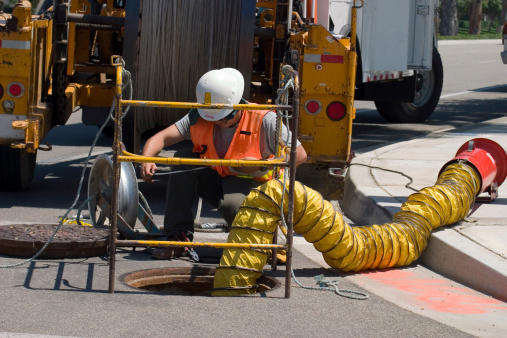
“Tight” spaces vary between individuals, so identifying confined spaces can be a difficult task. For some, hiding in a closet during hide-and-seek is fun, and for others, a few minutes in an elevator is a claustrophobic experience. What exactly is a confined space?
According to OSHA, confined spaces on a job site are areas not specifically designed for humans and include anything from a silo, pipeline, manhole or tank to an equipment warehouse, vault, pit or other tight space. These spaces are large enough to enter temporarily for maintenance, but usually require special equipment.
Confined spaces may not have natural oxygen or light supply and can be very dangerous. Dangers in these spaces can include exposure to toxic substances, electrocution through contact with exposed wires, and asphyxiation where there are low oxygen levels. At the very least, they present a difficult work environment for your staff, and it is important to be cautious and protect your team from harm.
Below are five guidelines to keep workers safe in confined spaces:
1. Identify confined spaces on the site.
OSHA identifies confined spaces using three criteria:
Identifying and preparing these spaces can make your job site a safe place for workers.
2. Never enter a confined space unless properly trained.
Workers should be trained on unique precautions and exit plans for confined spaces on their sites. Training prevents injuries, illness and other emergencies that could be caused by misuse of these areas.
3. Get required permits unless all expected hazards can be eliminated.
Before any work on a job site can begin, spaces in need of permits must be identified, and until permits are awarded, no entries can begin. To gain a permit, all threats in the space must be identified, allowing supervisors and workers to be aware of dangers within the space.
4. The entry supervisor must remain onsite during the entry period.
These supervisors are trained specifically to determine if a space is safe to enter, how long each worker can stay inside, and the necessary ventilation and standards for each space. They supervise all entries and exits to keep workers safe and must be onsite when workers enter a confined space.
5. Have an exit plan before entering a confined space.
Entry supervisors prepare exit plans for each space and train workers in case of an emergency. Site supervisors, along with entry supervisors and workers, should also be familiar with exit plans so any emergencies can be contained quickly and safely.
These five guidelines will assist in keeping workers safe within the site’s confined spaces. Though not all emergencies can be prevented, proper precautions will reduce risk and keep employees engaged on the site.
To learn more about our confined space training, click here!